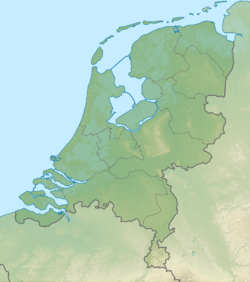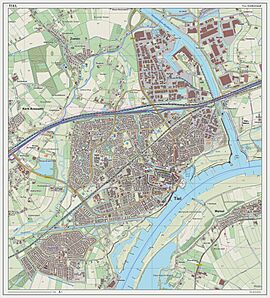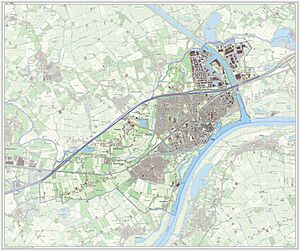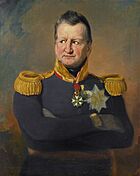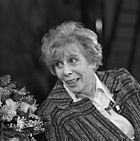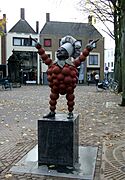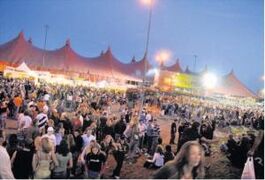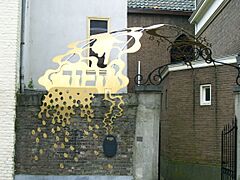Tiel facts for kids
Quick facts for kids
Tiel
|
|||
|---|---|---|---|
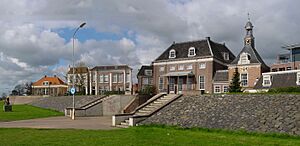
Fortified dyke in Tiel
|
|||
|
|||

Location in Gelderland
|
|||
| Country | Netherlands | ||
| Province | Gelderland | ||
| Government | |||
| • Body | Municipal council | ||
| Area | |||
| • Total | 34.81 km2 (13.44 sq mi) | ||
| • Land | 32.27 km2 (12.46 sq mi) | ||
| • Water | 2.54 km2 (0.98 sq mi) | ||
| Elevation | 7 m (23 ft) | ||
| Population
(May 2014)
|
|||
| • Total | 41,723 | ||
| • Density | 1,293/km2 (3,350/sq mi) | ||
| Demonym(s) | Tielenaar | ||
| Time zone | UTC+1 (CET) | ||
| • Summer (DST) | UTC+2 (CEST) | ||
| Postcode |
4000–4007, 4013–4014, 4017, 4062
|
||
| Area code | 0344 | ||
Tiel (Dutch pronunciation: [til]) is a municipality and a town in the middle of the Netherlands. The town is enclosed by the Waal river and the Linge river to the South and the North, and the Amsterdam-Rhine Canal to the East. Tiel comprises the population centres Kapel-Avezaath, Tiel and Wadenoijen. The city was founded in the 5th century CE.
Contents
The town of Tiel
Tiel is the largest town in the Betuwe area, which is famous for being one of the centres of Dutch fruit production. Orchards in the area produce apples, pears, plums and cherries. Tiel once housed the famous jam factory De Betuwe. After production was moved to Breda in 1993, the entire complex was demolished, although a part was reconstructed later. Reminding of this industry is a jam manufacturing museum and a statue of Flipje, the raspberry-based comic figure who starred in De Betuwe's, jam factory advertisements since the 1930s.
Originally located on the Linge river Tiel became an important centre of trade in the early Middle Ages, especially after the demise of Dorestad in the 9th century. Tiel had two big churches, one of which, the St. Walburg, was a collegiate church that belonged to the Teutonic Knights and vanished after the Reformation while the other church, the St. Maarten, became Protestant. Much of the historic centre was destroyed during the Second World War.
Every year, on the third Saturday in September, a festival known as Fruitcorso is held to celebrate the fruit harvest from the Betuwe area. On this day, a parade of wagons, decorated with fruit, travels through the city. Appelpop is a free, two-day music event that is held yearly on the second Friday and Saturday of September.
Tiel has also been known for its pewter industry. The last pewter factory and museum, which mainly produced collectibles for tourists, went bankrupt in early 2004, but has since been revived.
Ancient history
Roman artifacts (Rings, statues, grave stones etc) have been found in Tiel.
The "Stonehenge of the Netherlands" is an ancient site that is over 4,000 years old. The structure shows a similarity to Stonehenge in southern England; so it was dubbed "Stonehenge of the Netherlands" by the local media.
It was used as a burial mound and for religious practices. It is located in Tiel, Netherlands, and its excavation started in 2017. According to the town's website, this was the first such discovery in the Netherlands.
The mound contained remains of around 60 individuals. Three mounds were discovered; the main one is about 20 metres (65 ft) in diameter. Its passages align with the sun at equinoxes and solstices, and according to the archeologists it served as a solar calendar.
Around one million objects, dating from the Stone Age, Bronze Age, Iron Age, Roman Empire and throughout the Middle Ages, have been found. The oldest artifacts can be traced back to 2500 BCE.
One of the most interesting finds was a glass bead which is the oldest ever discovered in the Netherlands. The archeologists think it originated in Mesopotamia, modern day Iraq. The group assumes that the Bronze Age inhabitants of this area had contact with groups more than 3,000 miles away.
The archaeologists also discovered offerings like animal skeletons, human skulls and bronze spearheads.
Notable people
Public service
- Joan van der Capellen tot den Pol (1741–1784) statesman, active in the Batavian Republic
- David Hendrik Chassé (1765–1849) soldier who fought both for and against Napoleon
- Theodoor Gerard van Lidth de Jeude (1788–1863) physician, veterinarian and zoologist
- Antonie Frederik Jan Floris Jacob van Omphal (1788–1863) lieutenant-general and extraordinary aide-de-camp to William III of the Netherlands
- Cornelis Pijnacker Hordijk (1847–1908) jurist and politician, Governor-General of the Dutch East Indies 1888/1893
- William Hendriksen (1900–1982) New Testament scholar and writer of Bible commentaries
- Marinus van IJzendoorn (born 1952) human development professor, co-leader of Generation R
The arts
- Annie Foore (1847–1890) writer who lived in Dutch East Indies
- Mary Dresselhuys (1907–2004) stage actress
- Eylem Aladogan (born 1975) installation artist and sculptor
- Frans Duijts (born 1979) singer
- Abdellah Dami (born 1982) journalist, presenter and writer
- Corrie van Binsbergen (born 1957) jazzmusician and composer
Sport
- Herman Claudius van Riemsdijk (born 1948) chess player
- Jan van Deinsen (born 1953) football player
- Nico Rienks (born 1962) rower, two-time gold medallist at the 1988 and 1996 Summer Olympics
- Anton Janssen (born 1963) football player
- Wilma van Velsen (born 1964) swimmer and team bronze and silver medallist in the 1980 and 1984 Summer Olympics
- Dirk Jan Derksen (born 1972) football player
- Bobbie Traksel (born 1981) racing cyclist
- Erik Pieters (born 1988) football player
- Barry Maguire (born 1989) football player
- Mattijs Branderhorst (born 1993) football player
Gallery
See also
 In Spanish: Tiel para niños
In Spanish: Tiel para niños




